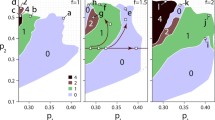Abstract
The equilibrium shapes of a closed DNA are investigated by employing a model of a thin, homogeneous, isotropic, linearly elastic rod of circular cross section. An equilibrium configuration of such an initially straight and twisted rod, submitted to external forces and moments at its ends only, obeys equations identical to those governing the rotation of a symmetric gyrostat spinning about a fixed point in a gravitational field (the Kirchhoff analogy). To represent the equilibrium of the looped DNA, the model rod must be smoothly closed into a ring. The corresponding BVP results in a system of four nonlinear equations with respect to four parameters. The perturbation analysis and the parameter continuation approach are used to find nonplanar solutions. The conformation change is discussed for various values of parameters.
Sommario
Si analizzano le configurazioni di equilibrio di una molecola chiusa di DNA per mezzo di un modello di trave sottile, omogenea, isotropa e linearmente elastica, con sezione circolare. La configurazione di equilibrio di una tale trave, inizialmente rettilinea e poi ritorta, soggetta a forze esterne e momenti solo alle sue estremità, è descritta dalla soluzione di equazioni identiche a quelle che governano il moto di un girostato simmetrico in rotazione intorno ad un punto fisso in un campo gravitazionale (l'analogie di Kirchhoff). Per poter rappresentare l'equilibrio del cappio di DNA, il modello di trave deve essere racchiuso in un anello, Il corrispondente problema al contorno consiste in un sistema di quattro equazioni nonlineari rispetto a quattro parametri. Le soluzioni del problema fuori del piano vengono ottenute tramite l'analisi perturbativa ed una procedura di continuazione al variare di un parametro. Si discutono le modifiche di configurazione del sistema per diversi valori dei parametri.
Similar content being viewed by others
References
CrickF. H. C., ‘Linking numbers and nucleosomes’, Proc. Natl. Acad. Sci. USA, 73 (8) (1976) 2639–2643.
TsuruH. and WadatiM., ‘Elastic model of highly supercoiled DNA’, Biopolymers, 25 (1986) 2083–2096.
BauerW. R., CrickF. H. C., WhiteJ. H., ‘Supercoiled DNA’, Scientific American, 243 (1) July (1980) 100–113.
BenhamC. J., ‘Elastic model of supercoiling’, Proc. Natl. Acad. Sci. USA, 74 (1977) 2397–2401.
LeBretM., ‘Catastrophic variation of twist and writhing of circular DNAs with constraint?’, Biopolymers, 18 (1979) 1709–1725.
BenhamC. J., ‘Geometry and mechanics of DNA superhelicity’, Biopolymers, 22 (1983) 2477–2495.
ŠelepováP., KyprJ., ‘Computer simulation of DNA supercoiling in a simple elastomechanical approximation’, Biopolymers, 24 (1985) 867–882.
WadatiM. and TsuruH., ‘Elastic model of looped DNA’, Physica 21D (1986) 213–216.
TanakaF. and TakahashiH., ‘Elastic theory of supercoiled DNA’, J. Chem. Phys. 83 (11) (1985) 6017–6026.
StarostinE. L., ‘Three-dimensional conformations of looped DNA in an elastomechanical approximation’. In: ChienWei-zang (ed.), Proceedings of the 2nd International Conference on Nonlinear Mechanics, Peking University Press, Beijing, 1993, pp. 188–190.
Love, A. E. H., A Treatise on the Mathematical Theory of Elasticity (4th edn), Cambridge University Press, 1927.
TsuruH., ‘Nonlinear dynamics for thin elastic rod’, J. Phys. Soc. Japan, 55 (7) (1986) 2177–2182.
TsuruH., ‘Equilibrium shapes and vibrations of thin elastic rod’, J. Phys. Soc. Japan, 56 (7) (1987) 2309–2324.
Domokos, G., A Group-Theoretic Approach to the Geometry of Elastic Rings, Technical Note BN-1168, Institute for Physical Science and Technology, University of Maryland, 1994.
CantorC. R., SchimmelP. R., Biophysical Chemistry. Part III. The Behavior of Biological Macromolecules, W. H. Freeman and Company, San Francisco, 1980.
FullerF. B., ‘The writhing number of a space curve’ Proc. Natl. Acad. Sci. USA, 68 (4) (1971) 815–819.
BarkleyM. D., ZimmB. H., J. Chem. Phys. 70 (1979) 2992–3007.
HoganM., LeGrangeJ. and AustinB., ‘Dependence of DNA helix flexibility on base composition’, Nature, 304 (25) (1983) 752–754.
LandauL. D. and LifshitzE. M., Theory of Elasticity (2nd edn), Pergamon, New York, Oxford, 1970.
IlyukhinA. A., Spatial Problems of the Nonlinear Theory of Elastic Rods, Naukova Dumka, Kiev, 1979 [in Russian].
AbramowitzM. and StegunI. A., Handbook of Mathematical Functions, Dover, New York, 1972.
Author information
Authors and Affiliations
Rights and permissions
About this article
Cite this article
Starostin, E.L. Three-dimensional shapes of looped DNA. Meccanica 31, 235–271 (1996). https://doi.org/10.1007/BF00426990
Received:
Accepted:
Issue Date:
DOI: https://doi.org/10.1007/BF00426990




